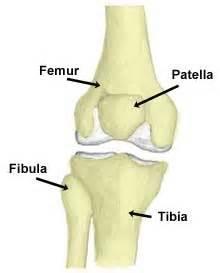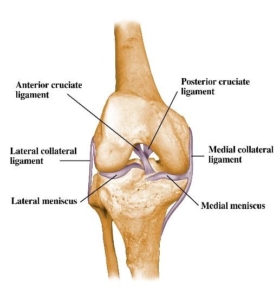What is the Knee Complex?
The knee is the largest and one of the most complex joints in the human body. It consists of 4 bones, multiple ligaments, muscles and tendons, cartilage and soft tissue. The knee is a modified hinge joint allowing primary motions of knee flexion and extension. The knee has some slight internal and external rotation as well. The joint and its components function together to provide stability and power for activities of daily living and athletic movements. However, any of these structures can be injured or damaged requiring treatment as easy as bracing, rest and therapy to as complex as surgery to correct. Regardless, either treatment will typically allow a full return to activity or sports without additional complications.

Boney structures of the knee consist of the patella (knee cap), Femur (thigh bone), Tibia and Fibula (lower leg bones).
Ligaments
Ligaments of the knee are classified as cruciate and collateral ligaments. Ligaments connect bone to bone. The major ligaments of the knee consist of the ACL (anterior cruciate ligament, PCL (posterior cruciate ligament), MCL (medial collateral ligament) and LCL (lateral collateral ligament).
- Cruciate ligaments are within the knee joint. They prevent anterior (forward) and posterior (backward) translation of the femur from the tibia.
- Collateral ligaments are outside the knee joint and prevent medial (inside) and lateral (outside) instability.

Cartilage
Cartilage within the knee is classified into two categories.
- Articular cartilage is the protective covering over the ends of the bones. This allows the joint to glide permitting fluid motion during active and passive activities.
Meniscus is the additional form of cartilage within the knee called fibrocartilage. The purpose of your two meniscuses (medial – inside and lateral – outside) is to act as cushions between your femur (thigh bone) and tibia (lower leg bone).

Muscles
Muscles are connected to the bone by tendons. Muscles and tendons provide the motion of the joint. The quadriceps (thigh muscle) is connected to the patella (knee cap) by the quadriceps tendon. After crossing over the patella, the patellar tendon inserts onto the tibial tubercle (upper portion of your shin). These tendons promote knee extension – straightening of the knee.

